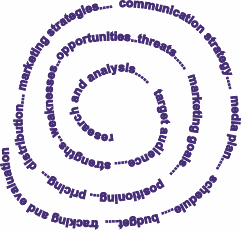When it comes to identifying your marketing strategies, think about how you are going make your product stand out from the pack. If you have a product that no one else offers, your job is not so difficult. If you don't then you have a little more work ahead of you. Find (or create) your competitive edge. What is your Unique Selling Advantage? If your product does what the others do but you can offer it cheaper then you're on to something. If your product is packed with features that the others don't offer then you're also on to something. Whatever it is, find the differences in your product or service and capitalize on them.
One method for brainstorming is to put yourself in your customers' shoes! Walk the walk and talk the talk. Ask yourself why you buy one product over another. What media do you really pay attention to? All these thought processes will help you nail down the best strategies for getting your products into your potential customers' hands.
In this section, present an overview of your strategies and then move into how you are going to position your product, how you will price it, and how you plan to promote and distribute it.
How you position your product is how you want your target market to perceive it in the marketplace. Is it the premier product for business executives, or is it a less expensive alternative to the "big guy's" product? Do you want your product to be seen as an investment or an expense? Put into words the ideas you came up with while "walking the walk" above. According to David Ogilvy, founder of an extremely successful advertising agency, positioning is the most important aspect of your marketing efforts. You have to find your niche.
Also explain how you price your product in this section. Start with how your main competitors price their products. Is your product better (be objective!), or just comparable to theirs? Have you done any research into what people would pay for your product? Get as much competitive pricing information as possible and combine that information with a feature comparison. If your product is obviously better (be objective!) then you can probably price it at or above your established competitors' prices. If it isn't then you probably should lower your price in order to get a share of the market. Pricing increases can come later once you have a good hold on a piece of the market.
Once you've established your product's position and pricing, move into the exciting world of promotion and advertising. This should cover every avenue you'll travel in getting the word out about your business and your products or services, from free promotion via press releases, to trade shows, to million dollar TV ad campaigns. Your promotions should always have specific goals. For example, are you trying to build brand awareness, make immediate sales, promote a special event, or simply generate interest and leads?
Once you have goals set, build on the information you've already assembled about your target market and your marketing strategies, and once again, get into your prospects' heads. What media do they use? What are their buying habits? Where would your advertising dollars be best spent? What are their interests? How can you use that information to sell your product or otherwise meet the goals you've just set?
For example, let's use a Brady Bunch illustration and say we are in the business of selling cars -- specifically cars with a high passenger capacity. If the Brady's fall into our Target Audience, we know that our audience watches little TV, reads the newspaper, tends to make decisions as a family (so getting the attention of the kids is key), and likes to travel by car on long trips out west. Therefore, our advertising and promotions would probably work best in print -- specifically newspaper -- and our sales literature and other tactics need to be designed with kids in mind.
Now, that example is definitely oversimplified, but you should get the idea of what you have to think about. Basically you have to decide, based on your audience's habits:
- what your advertising message should be,
- how you need to say it,
- and where you need to say it.
In the promotions section of business plan, briefly explain the what, how and where listed above. The "where" part of those questions is called your advertising mix and is sometimes the easiest of the three to determine. This section doesn't always have to be that detailed. In other words, you don't have go into exactly what your advertising themes will be unless you feel they are key to your business's success. Save those details for your marketing plan.
Next discuss how your product will be distributed. Will you go through retail chains, online sales, direct sales, etc? Describe the standard distribution channels for your industry, and explain the strengths and weaknesses of each method. Is one channel better from a financial standpoint, but not from a customer service standpoint? Will you have a network of distributors? There are several options for distribution channels including retail outlets (either your own or an existing chain), wholesale outlets, sales force, telemarketing, cybermarketing, or direct marketing on TV and cable shopping channels.


